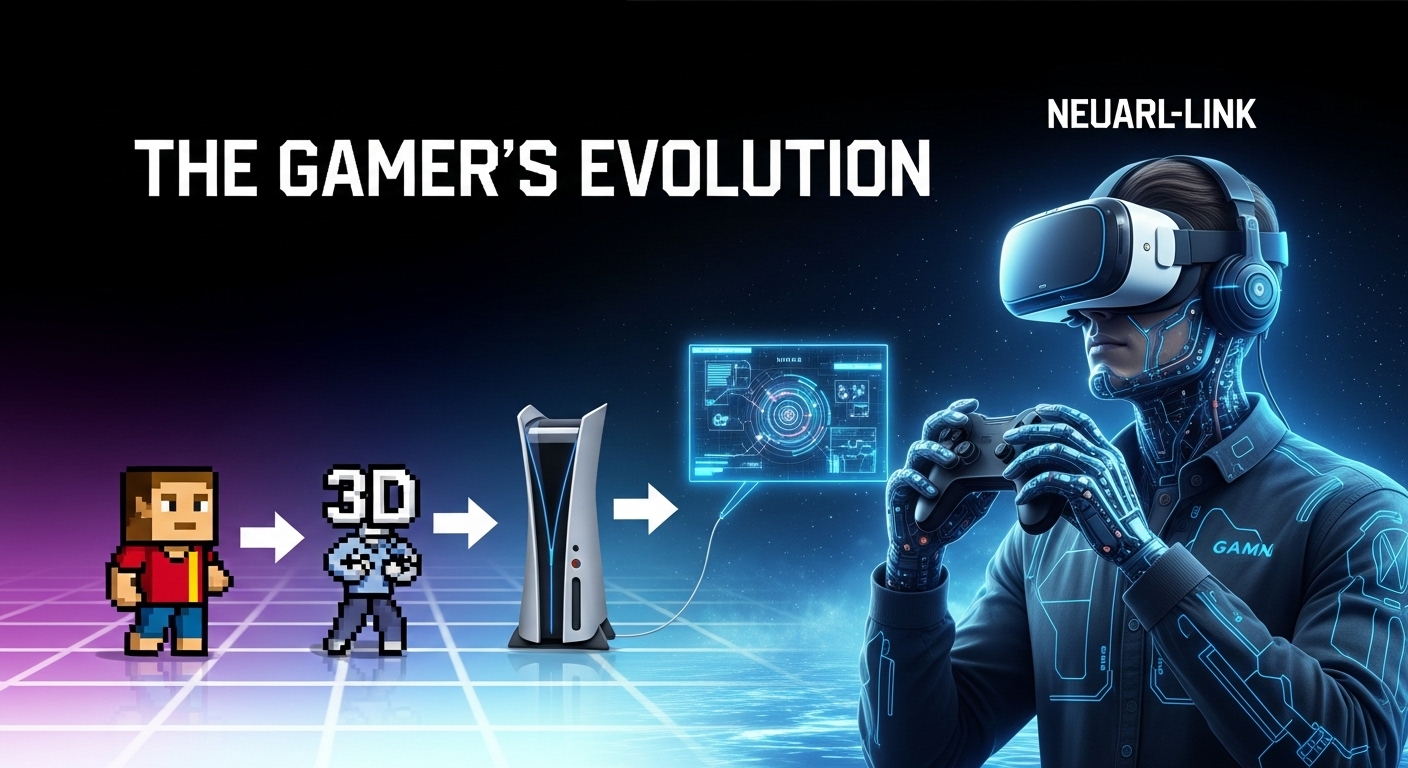Introduction: A World Transformed by Play
Gaming is no longer just a pastime. What began as a niche hobby with pixelated graphics and simple controls has evolved into a multi-billion-dollar industry that rivals film and music combined. It has become an art form, a sport, a culture, and a shared experience connecting millions across the globe. Whether played on consoles, computers, or mobile devices, games have transformed how people interact, think, and create.
The journey of gaming is a remarkable story — one that traces technological progress, human imagination, and the never-ending pursuit of fun. From the blinking lights of arcade machines to the photorealistic worlds of modern consoles, gaming reflects not only advancements in technology but also shifts in culture and society.
The Early Days: Birth of an Industry
The roots of gaming go back to the mid-20th century, when scientists and engineers began experimenting with interactive computer programs. One of the first recognizable video games was “Tennis for Two” in 1958, a simple tennis simulation displayed on an oscilloscope. A few years later, “Spacewar!” arrived at MIT, capturing the imagination of students who would go on to influence early gaming technology.
By the 1970s, the concept of gaming began to spread beyond laboratories. Arcades emerged as social spaces where people could compete for high scores on machines like Pong and Space Invaders. These early games were basic, yet addictive, sparking the public’s fascination with interactive entertainment. The release of the Atari 2600 in 1977 brought gaming into living rooms for the first time, allowing players to experience the thrill of arcade action at home.
The seeds of a global industry were sown. What was once an experiment had become a cultural phenomenon.
The Golden Age of Consoles: 1980s to 1990s
The 1980s marked a golden age in gaming history. It was a period of innovation, competition, and iconic creations. Nintendo entered the market with its legendary Nintendo Entertainment System (NES), introducing characters like Mario, Link, and Donkey Kong. These games emphasized fun gameplay over graphics, creating timeless experiences that are still beloved today.
Meanwhile, Sega challenged Nintendo’s dominance with the Sega Genesis, giving birth to the famous rivalry between Mario and Sonic — two mascots that defined a generation. This competition pushed both companies to innovate rapidly, improving game design, music, and storytelling.
By the 1990s, the gaming landscape had changed once again with the rise of Sony’s PlayStation. The jump from 2D to 3D graphics opened a new world of possibilities. Games like Final Fantasy VII, Tomb Raider, and Metal Gear Solid showed that games could tell complex, emotional stories on par with movies. For the first time, gaming was recognized not just as entertainment, but as a form of art.
The Rise of the PC and Online Gaming
While consoles were thriving, personal computers were quietly shaping a different gaming revolution. The flexibility of PC hardware and software allowed developers to experiment with genres that were difficult to replicate on consoles. Strategy games, simulations, and first-person shooters became PC staples.
The 1990s saw the birth of Doom and Quake, which not only defined the FPS genre but also introduced multiplayer gaming through local area networks (LAN). These games laid the groundwork for online gaming communities that would later dominate the 2000s.
As the internet became accessible, online gaming took off. Titles like Counter-Strike, World of Warcraft, and Runescape built massive global communities. Gamers could now connect with strangers across continents, forming friendships and rivalries in virtual worlds. The idea of gaming as a social experience was solidified.
The 2000s: Gaming Goes Mainstream
By the early 2000s, gaming was no longer just a hobby — it was mainstream entertainment. Sony’s PlayStation 2 became one of the best-selling consoles of all time, while Microsoft entered the scene with the Xbox, introducing features like online play through Xbox Live. Meanwhile, Nintendo continued to innovate, focusing on accessible fun with the Wii’s motion controls, bringing gaming to families and older generations.
During this period, gaming’s visual fidelity reached new heights. Titles like Grand Theft Auto III, Halo, and The Elder Scrolls III: Morrowind pushed the limits of open-world design and storytelling. Game developers were becoming storytellers and world-builders, crafting experiences that blurred the line between cinema and play.
Mobile phones also began to emerge as gaming devices. Simple titles like Snake and Tetris on handheld devices introduced millions to gaming, foreshadowing the mobile revolution that was yet to come.
The Modern Era: The Power of Connectivity and Community
The 2010s transformed gaming from an individual experience into a community-driven phenomenon. Streaming platforms like Twitch and YouTube Gaming allowed players to broadcast their gameplay to the world. Suddenly, gamers were not just playing games — they were performing, entertaining, and creating content.
Esports became a global sensation. Competitive games like League of Legends, Dota 2, and Counter-Strike: Global Offensive filled arenas with thousands of fans and millions more watching online. Professional gamers became celebrities, earning sponsorships and competing for multi-million-dollar prizes. Gaming had reached a level of legitimacy previously unimaginable.
At the same time, indie developers began to thrive. Digital distribution platforms allowed small studios and individuals to release their games to a worldwide audience without the need for major publishers. Titles like Undertale, Celeste, and Stardew Valley proved that creativity and storytelling could triumph over big budgets.
The Rise of Mobile Gaming: A New Frontier
When smartphones became mainstream, gaming underwent another revolution. Suddenly, everyone with a phone was a potential gamer. Mobile titles like Angry Birds, Clash of Clans, and Candy Crush Saga introduced casual gaming to audiences who had never considered themselves players.
The accessibility of mobile gaming blurred demographic lines. It was no longer just teenagers or hobbyists who played — parents, professionals, and even grandparents were engaging with digital games. The global mobile gaming market grew rapidly, surpassing console and PC gaming revenues combined.
However, this shift also brought new challenges. The rise of microtransactions, advertisements, and “freemium” models sparked debates about the ethics of game monetization. Still, mobile gaming demonstrated that the medium’s power lies in its ability to adapt and reach everyone, everywhere.
The Art and Emotion of Games
While technology drives gaming forward, the heart of the medium lies in its emotional and artistic expression. Modern games tell stories that resonate deeply with players. Titles like The Last of Us, Red Dead Redemption 2, and Journey are celebrated for their narrative depth and emotional impact.
Games offer a unique form of storytelling — one where the player participates in the narrative, shaping its outcome through choices and actions. This interactivity makes gaming unlike any other medium. It invites empathy, curiosity, and introspection. Players don’t just watch a story unfold; they live it.
Visually, gaming has embraced artistic diversity. From hand-drawn indie games to hyper-realistic blockbusters, every visual style has a purpose and a message. Sound design, music, and voice acting have also reached cinematic quality, turning gaming into a truly immersive art form.
Gaming as a Social Platform
Today’s games are not just entertainment — they are social hubs. Online multiplayer titles like Fortnite, Minecraft, and Roblox have evolved into digital meeting places where players build, chat, and create together. For many, these worlds serve as modern playgrounds or social clubs.
The pandemic of 2020 highlighted gaming’s social importance. As physical gatherings became difficult, games provided a safe space for people to connect, communicate, and share experiences. Virtual concerts, community events, and even weddings have been hosted within games, proving that digital worlds can foster genuine human connection.
The Business of Gaming
The gaming industry today is one of the largest and most profitable entertainment sectors in the world. It drives technological innovation, from graphics processing to artificial intelligence. Major studios and independent developers coexist in a dynamic ecosystem where creativity meets commerce.
The economic impact of gaming extends far beyond developers and publishers. Streaming, content creation, esports, and merchandise have created entire sub-industries. Game marketing has evolved into a spectacle, with announcements and trailers generating excitement comparable to blockbuster film releases.
Yet, with great success comes great scrutiny. Discussions around crunch culture, diversity, representation, and inclusivity have become central to gaming’s future. The industry continues to mature, learning to balance profit with ethics and community values.
The Psychology of Gaming
Why do people play games? The answer lies in psychology. Games fulfill basic human needs — achievement, social connection, exploration, and relaxation. They offer challenges, rewards, and a sense of progression that mirrors real-life goals but in a more controlled and satisfying environment.
For many, gaming is an escape from stress, a way to unwind and recharge. For others, it is a platform for self-expression and creativity. Studies have even shown cognitive benefits, such as improved problem-solving, coordination, and strategic thinking.
However, like any form of entertainment, gaming requires balance. Excessive play can lead to burnout or social withdrawal. The key lies in moderation and understanding why we play — for joy, for connection, or simply for curiosity.
The Cultural Impact of Gaming
Gaming has woven itself into global culture. Characters like Mario, Lara Croft, and Master Chief are as recognizable as movie icons. Game music is performed in orchestras; fashion brands collaborate with gaming franchises; films and TV shows adapt game stories for the screen.
The influence of gaming can also be seen in education, healthcare, and social change. Educational games teach languages and logic. Virtual reality helps train surgeons. Interactive simulations raise awareness about mental health, climate change, and history. Gaming’s power lies in its ability to educate through engagement.
Moreover, gaming communities are among the most passionate and creative groups on the internet. From fan art to mods and cosplay, players actively contribute to the culture, shaping how games evolve and how they are remembered.
The Future of Gaming: Beyond Reality
The future of gaming promises even more transformation. Virtual reality (VR) and augmented reality (AR) are redefining immersion, allowing players to step inside the game world. Artificial intelligence is enhancing realism, adapting gameplay to individual players.
Cloud gaming aims to remove hardware barriers entirely, enabling anyone with an internet connection to play the latest games without expensive consoles. Meanwhile, cross-platform play is uniting players regardless of their device.
The line between gaming and reality continues to blur. Future games might integrate biometric feedback, voice recognition, and adaptive storytelling that responds to emotion. The next frontier of gaming will not only be about what we play — but how we experience it.
The Debate Around Gaming: Challenges and Misconceptions
Despite its success, gaming faces ongoing debates. Concerns about violence, addiction, and representation often dominate discussions. However, research increasingly suggests that context matters more than content. Games, like films or books, reflect diverse themes — some dark, some inspiring.
The conversation has also expanded to inclusivity and accessibility. Developers are now designing games that accommodate different abilities, ensuring everyone can participate. The industry is gradually learning that diversity in characters, stories, and creators leads to richer, more authentic experiences.
Society’s perception of gamers has evolved, too. No longer are players seen as isolated individuals in dark rooms; they are creators, competitors, and community members. Gaming is for everyone — all ages, all cultures, all backgrounds.
Conclusion: The Game Never Ends
Gaming is more than a digital pastime — it is a living, breathing culture that continues to evolve. It reflects human creativity, curiosity, and the desire to connect. From its humble beginnings in laboratories to its modern global dominance, gaming has redefined how we experience stories, competition, and art.
Every generation of gamers brings new ideas, new heroes, and new dreams. Whether through console, PC, or mobile, the essence of gaming remains unchanged: the joy of play, the thrill of discovery, and the bond of shared experience.
The future of gaming is bright, limitless, and waiting to be written — one level, one story, one player at a time.



